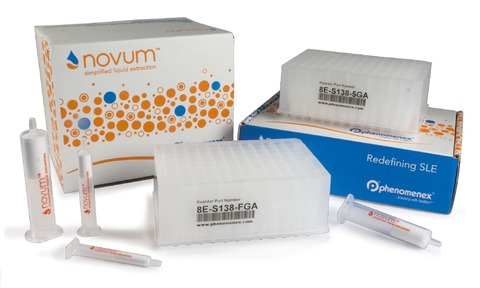
Phenomenex has extended its novel Novum Simplified Liquid Extraction (SLE) sorbent line to include tube formats, in addition to the original 96-well plate formats.
Novum is a synthetic alternative to traditional diatomaceous earth SLE (also known as supported liquid extraction) products and provides a simplified approach to traditional liquid-liquid extraction (LLE).
Novum is now available in 1, 3, 6 and 12 cc tubes, expanding the sorbent’s benefits to larger format applications including food safety and quality, personal care products and environmental analysis.
Novum tubes can be automated using a liquid handler and can also be run using a cost-effective vacuum manifold to run 12 or 24 samples at once for increased throughput over traditional LLE.
The original plate format is ideal for high-throughput clinical, forensic and pharmaceutical research analysis.
Extraction techniques used prior to LC and GC can improve results and reduce wear and tear on the instrument.
The synthetic Novum SLE sorbent (patent pending) can be used with the same solvents as traditional SLE sorbents while delivering improved lot-to-lot reproducibility.
Because it is a lab-manufactured sorbent, supplies are readily available, compared to diatomaceous earth, which is a natural resource that must be mined.
Novum SLE is designed to simplify the liquid-liquid extraction process by eliminating manual steps and reducing solvent consumption. SLE also delivers higher sample recovery than liquid-liquid extraction methods by eliminating analyte loss due to emulsions that can form at the interface of the two liquid phases.
“Novum has been very well received by researchers who are experiencing easier and faster sample preparation,” said Erica Pike, brand manager for Phenomenex.
“And because we manufacture the sorbent, we are able to provide lot-to-lot consistency, which is extremely important for labs using validated methods that rely on reproducible results.”
In the SLE process, aqueous sample is loaded onto the sorbent, which works like a sponge and retains the solvents.
Target analytes can then be eluted by applying water-immiscible solvent, which is then collected in a collection plate. With this new method, the solvents are not shaken, which eliminates the formation of emulsions that occur during a typical liquid-liquid extraction.
“This product bridges the gap between liquid-liquid extraction and solid phase extraction,” explained Pike.




